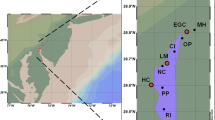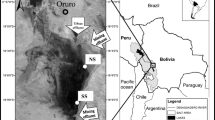Abstract
An overview of a comprehensive study of the behavior and fate of mercury in the estuarine Patuxent River is presented. Total Hg (HgT) and methylmercury (MeHg) exhibited weakly non-conservative behavior in the estuary. Total Hg concentrations ranged from 6 ng L-1 in the upper reaches of the sub-urbanized tidal freshwater river to <0.5 ng L-1 in the mesohaline lower estuary. Filterable (0.2 µm) HgT ranged from 0.2 to 1.5 ng L-1. On average, MeHg accounted for <5% of unfiltered HgT and <2% of filterable HgT. Dissolved gaseous section Hg (DGHg) concentrations were highest (up to 150 pg L-1) in the summer in the mesohaline, but were not well correlated with primary production or chlorophyll a, demonstrating the complex nature of Hg0 formation and cycling in an estuarine environment. Organic matter content appeared to control the HgT content of sediments, while MeHg in sediments was positively correlated with HgT and organic matter, and negatively correlated with sulfide. MeHg in sediments was low (0.1 to 0.5% of HgT). Preliminary findings suggest that net MeHg production within sediments exceeds net accumulation. Although HgT in pore waters increased with increasing sulfide, bulk MeHg concentrations decreased. The concentration of MeHg in sediments was not related to the concentration of HgT in pore waters. These observations support the hypothesis that sulfide affects the speciation and therefore bioavailability of dissolved and/or solid-phase Hg for methylation. Comparison with other ecosystems, and the negative correlation between pore water sulfide and sediment MeHg, suggest that sulfide limits production and accumulation of MeHg in this system.
Similar content being viewed by others
References
Andren AW & Harriss RC (1973) Methylmercury in estuarine sediments. Nature 245: 256–257
Bartlett PD & Craig PJ (1981) Total mercury and methyl mercury levels in British estuarine sediments – 2. Water Res. 15: 37–47
Bloom N (1989) Determination of picogram levels of methylmercury by aqueous phase ethylation followed by cryogenic gas chromatography with cold vapour atomic fluorescence detection. Can. J. Fish. Aquat. Sci. 46: 1131–1140
Bloom N & Fitzgerald WF (1988) Determination of volatile mercury species at the picogram level by low-temperature gas chromatography with cold vapour atomic fluorescence detection. Anal. Chim. Acta 208: 151–161
Bloom NS, Watras CJ & Hurley JP (1991) Impact of acidification on the MeHg cycling of remote seepage lakes. Water Air Soil Poll. 56: 477
Boynton WR, Garber JH, Summers R & Kemp WM (1995) Inputs, transformations, and transport of nitrogen and phosphorus in Chesapeake Bay and selected tributaries. Estuaries 18: 285–314
Choi, S-C & Bartha R (1994) Environmental factors affecting mercury methylation in estuarine sediments. Bull. Environ. Contam. Tox. 53: 805–812
Compeau G & Bartha R (1985) Sulfate-reducing bacteria: principle methylators of mercury in anoxic estuarine sediment. Appl. Environ. Microbiol. 50: 498–502
Coquery M, Cossa D & Martin JM (1995) The distribution of dissolved and particulate mercury in three Siberian estuaries and adjacent arctic coastal waters. Water Air Soil Poll. 80: 653–664
Cossa D, Gobeil C & Courau P (1988) Dissolved mercury behaviour in the St. Lawrence estuary. Estuarine Coastal Shelf Sci. 26: 227–230
Cronin WB & Pritchard DW (1975) Additional statistics on the dimensions of the Chesapeake Bay and its tributaries: Cross-section widths and segment volumes per meter depth. Special Report 42. Chesapeake Bay Institute, The John Hopkins University. Reference 75-3. Baltimore, MD
Dyrssen D & Wedborg P (1991) The sulphur-mercury (II) system in natural waters. Water Air Soil Poll. 56: 507–519
Flegal AR, Smith GJ, Gill GA, Sanudo-Wilhelmy S & Anderson LCD (1991) Dissolved trace element cycles in the San Fransisco Bay Estuary. Mar. Chem. 36: 329–363
Gagnon C, Pelletier E, Mucci A & Fitzgerald WF (1996) Diagenetic behavior of methylmercury in organic-rich coastal sediments. Limnol. Oceanogr. 41: 428–434
Gill GA & Fitzgerald WF (1987) Picomolar mercury measurements in seawater and other materials using stannous chloride reduction and two-stage gold amalgamation with gas phase detection. Marine Chem. 20: 227–243
Gilmour CC, Riedel GS, Ederington MC, Bell JT, Benoit JM, Gill GA & Stordal MC (1997) Mercury concentrations and production rates across a trophic gradient in the northern Everglades. Biogeochemistry 40: 327–345
Gilmour CC & Riedel GS (1995) Measurement of Hg methylation in sediments using high specific-activity 203Hg and ambient incubation. Water Air Soil Poll. 80: 747–756
Gilmour CC, Henry EA & Mitchell R (1992) Sulfate stimulation of mercury methylation in freshwater sediments. Environ. Sci. Technol. 26: 2281–2287
Gilmour CC & Henry EA (1991) Mercury methylation in aquatic systems affected by acid deposition. Environ. Poll. 71: 131–169
Gobeil C & Cossa D (1994) Mercury in sediments and sediment porewater in the Laurentian Trough. Can. J. Fish. Aquat. Sci. 50: 1794–1800
Hagy JD (1996) Residence times and net ecosystem processes in Patuxent River Estuary. M.S. Thesis, Univ. Maryland. 205 p
Henry EA, Dodge-Murphy LJ, Bigham GN, Klein SM & Gilmour CC (1995) Total mercury and methylmercury mass balance in an alkaline, hypereutrophic urban lake (Onondaga Lake, N.Y.).Water Air Soil Poll. 80: 489–498
Horvat M, Bloom NS & Liang L (1993a) Comparison of distillation with other current isolation methods for the determination of MeHg compounds in low level environmental samples. Part I. Sediment. Anal. Chim. Acta 282: 135–152
Horvat M, Liang L & Bloom NS (1993b) Comparison of distillation with other current isolation methods for the determination of MeHg compounds in low level environmental samples. Part II. Water. Anal. Chim. Acta 282: 153–168
Lacouture RV & Brownlee S (1996) Long term trends in Plankton Dynamics, Potomac and Patuxent Rivers. Report to the Maryland Dept. of the Environment
Leermakers M, Meuleman C & Baeyens W (1995) Mercury speciation in the Scheldt Estuary. Water Air Soil Poll. 80: 641–652
Mason RP, Fitzgerald WF, Hurley J, Hanson Jr AK, Donaghay PL & Seiburth JM (1993) Mercury biogeochemical cycling in a stratified estuary. Limnol. Oceanogr. 38: 1227–1241
Mason RP, Morel FMM & Hemond HF (1995) The role of microorganisms in elemental mercury formation in natural waters. Water Air Soil Poll. 80: 775–787
Sanders JG & Riedel GF (1993) Trace element transformation during the development of an algal bloom. Estuaries 16: 521–532
Schwarzenbach G & Widmer M (1963) Die Loslichkeit von Metallsulfiden. I. Schwarzes Quecksilbersulfid. Helv. Chim. Acta. 46: 2613–2628
St. Louis VL, Rudd JMW, Kelly CA, Beaty KG, Bloom NS & Flett RJ (1994) The importance of wetlands as sources of methyl mercury to boreal forest ecosystems. Can. J. Fish. Aquat. Sci. 51: 1065–1076
Stordal MC, Gill GA, Wen L-S & Santschi PH (1996) Mercury phase speciation in the surface waters of three Texas estuaries: Importance of colloidal forms. Limnol. Oceanogr. 41: 52–61
United States Environmental Protection Agency, Chespeake Bay Program (1994) Chesapeake Bay Basin Toxics Loading and Release Inventory. CBP/TRS 102/94
Vandal GM & Fitzgerald WF (1995) A preliminary mercury budget for Narragansett Bay (Rhode Island, USA). Water Air Soil Poll. 80: 679–682
Verta M & Matilainen T (1995) Methylmercury distribution and partitioning in stratified Finnish forest lakes. Water Air Soil Poll. 80: 585–588
Watras CJ, Bloom NS, Claas SA, Morrison KA, Gilmour CC & Craig SR (1995) Methylmercury production in the anoxic hypolimnion of a dimictic seepage lake. Water Air Soil Poll. 80: 735–745
Rights and permissions
About this article
Cite this article
Benoit, J., Gilmour*, C., Mason, R. et al. Behavior of mercury in the Patuxent River estuary. Biogeochemistry 40, 249–265 (1998). https://doi.org/10.1023/A:1005905700864
Issue Date:
DOI: https://doi.org/10.1023/A:1005905700864




